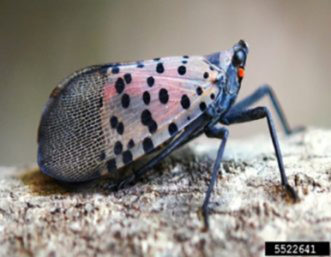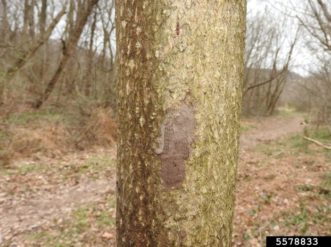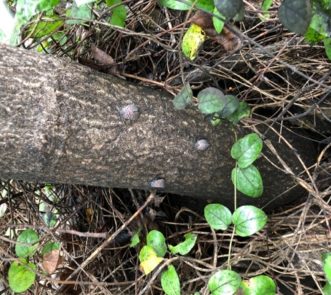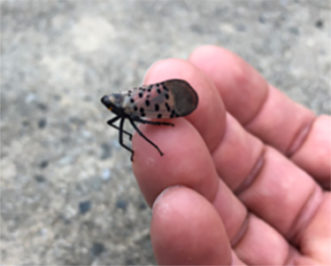Spotted lanternfly, Lycorma delicatula (White)
Introduction
Spotted lanternfly (SLF) is an invasive pest new to the United States. Despite its common name, SLF is not a fly, but a large planthopper (Hemiptera: Fulgoridae) (figures 1A and 1B). It is native to parts of China, Bangladesh, and Vietnam, but has spread across eastern Asia. It was first identified in North America in 2014 from Berks County, Pennsylvania.1 Populations are established in Delaware (2017), Virginia (2018), and New Jersey (2018), and SLF has been detected in New York (2017), Connecticut (2018), and Maryland (2018), though no confirmed populations exist in those states. County-level quarantines have been imposed on several counties in southeastern Pennsylvania and northwestern New Jersey as of 2018.

Figure 1A. one-inch-long by one-half-inch-high spotted lanternfly perched atop a log. The spotted lanternfly pictured has a black head with a red spot below its eye. Its abdomen is also mostly black, with slight yellow bands. The forewings are grayish, adorned with black spots, and the hind wings are banded black and white anteriorly and deep red posteriorly. Image credit: Lawrence Barringer, PA Dept. of Agriculture, bugwood.org.
SLF has not been detected in South Carolina or Georgia. It is, however, possible that silvicultural and horticultural crop producers in the region will be impacted by SLF as the species continues to spread and establish in the eastern United States. This bulletin is intended to provide information on SLF identification, life cycle, hosts, and current management options to prepare citizens and growers in South Carolina and Georgia for the potential invasion of SLF.
Description and Life Cycle
SLF has one generation per year in the Mid-Atlantic region of the United States where it is currently found. The insect overwinters as eggs, which are laid in the fall. Eggs are deposited in masses of thirty to fifty and covered in grayish, inconspicuous waxy deposits (figure 2). The eggs can be hard to spot on plant material, but can also be found on non-plant material, such as rocks, vehicles, and equipment, increasing the risk of increasing their distribution. The immature SLF (nymphs) hatch in spring and go through four instars (nymph stages) over about eight weeks (figure 3). Nymphs are initially black with white spots, only developing bright red spots during the final instar before becoming adults. Adults are present beginning in mid-summer and are approximately one-inch long and a one-half inch wide, with a black head and an abdomen that is mostly black but may have yellow bands. The forewings are grayish, adorned with black spots, and the hind wings are banded black and white anteriorly and deep red posteriorly. Adults have wings and can fly from tree to tree; they are also strong jumpers, frequently hopping from location to location. Adults feed throughout the summer, mate, and lay eggs in the fall.

Figure 2. A grey spotted lanternfly egg mass on an Ailanthus altissima (tree-of-heaven) stem. In this photo the bottom portion of the egg mass still has some grey material covering the eggs; this material is deposited by the adults when they lay the eggs. This has worn off on the top part of the egg mass, revealing rows of eggs. Image credit: Richard Gardner, Bugwood.org.
Hosts and Damage
SLF is a generalist herbivore and has been reported to feed on over seventy host plant species, including several important forestry and horticultural crops that are grown in the Southeast. Observations by researchers at Penn State University suggested that SLF feeds readily on Malus spp. (apple), Prunus spp. (plums, peaches, nectarines, cherries), and Vitis spp. (grapes, crop and wild). SLF may prefer tree species that produce toxic secondary compounds, such as Ailanthus altissima (tree-of-heaven) or Juglans nigra (black walnut).2
With the exception of conifers, all tree species planted for forestry in Georgia and South Carolina are potential feeding hosts of SLF. SLF prefers the tree-of-heaven but is also known to feed on Acer spp. (maple), Betula spp. (birch), Quercus spp. (oak), Juglans spp. (walnut), Salix spp. (willow), Platanus spp. (sycamore), and many other hardwood species. Many of the above plant species are also planted as ornamental trees and shrubs in ornamental landscapes. Ornamental plant species that are known to associate with SLF infestation include Robinia pseudoacacia (black locust), Acer palmatum (Japanese maple), Acer rubrum (red maple), Syringa spp. (lilac), Quercus spp., Rosa spp. (roses), Liriodendron tulipifera (tulip tree), and Zelkova spp. (zelkova), among others. Feeding has also been recorded on various vegetables and fruits including Cucumis sativus (cucumber), Ocimum basilicum (basil), and Vaccinium spp. (blueberry). Feeding by SLF results in black sooty mold growing on fluid excreted from the insect, which coats whatever may be underneath the host plant (figure 4).

Figure 4. Spotted lanternflies excrete a large amount of honeydew (waste fluid, mostly sugar and water) from their posterior when they feed. This fluid drops down the stem of the plant and also covers vegetation and the ground below. Sooty mold then grows on this honeydew, this is shown as all the black discoloration on and around this Ailanthus altissima (tree-of-heaven). Image credit: David Coyle, Clemson University.
Growers may be impacted by quarantine or regulations imposed on interstate or intrastate shipment of plant materials due to SLF infestations. Christmas trees, ornamental trees and shrubs, and/or tree seedlings containing egg masses or insects (dead or alive) may be rejected by the receiving state.
Management
Survey and Monitoring
Early in the season SLF may be common on non-tree hosts like Toxicodendron radicans (poison ivy), Lonicera spp. (honeysuckle), and Rhus glabra (smooth sumac). SLF congregate in large number and often infest tree-of-heaven, Juglans nigra (black walnut), and both cultivated and wild grape before other tree species. Therefore, regular inspection of these plant species at the edges of wood lines or nurseries can help detect early invasion into fruit, ornamental, and forestry plantings. Sticky bands are commonly used to monitor SLF populations. No baits are currently available for monitoring SLF populations, and research is ongoing to develop such monitoring tools.
The sighting of a suspected infestation must be reported immediately to your local Clemson Extension Office or University of Georgia Extension office, Clemson University Department of Plant Industry, or Georgia Department of Agriculture – Plant Industry Division. Because an expert must carefully examine an insect specimen to confirm its identity, the relevant authorities may visit your location to collect insects. You may also collect samples of multiple insects and bring them to your local extension office for shipment to experts for identification. Your local extension agents can also help you contact the relevant authority. Remember, confirm the identity of SLF before making any management plan.
Insecticides
While SLF is a certain threat to several fruit and nut crops, it is also highly susceptible to broad-spectrum insecticides in the pyrethroid, neonicotinoid, and organophosphate classes. Unfortunately, since SLF is a new insect in the United States, insecticides registered for use in fruit crops, such as apple, peach, and grape, or forestry crops, specifically hardwood tree nurseries, are not currently labeled for use to control SLF. However, many insecticides already applied to manage other fruit and forestry pests, such as stink bugs, sharpshooters, and defoliators, will provide some defense against SLF infestation and damage (table 1). Remember, the label is the law, and all pesticides must be applied according to label directions and rates.
Table 1. Insecticides registered for management of planthoppers and treehoppers in South Carolina and Georgia.
| IRAC No.1 | Chemical class | Active ingredient | Example trade names |
| 1A | Carbamates | carbaryl | Carbaryl 4L, Sevin SL |
| 1B | Organophosphates | acephate | Chevron, Kitron, Orthene, Ortho |
| chlorpyrifos | Chlorpyrifos SPC, Dursban 50W | ||
| dicrotophos | Inject-A-Cide B | ||
| malathion | Mathathion | ||
| naled | Dibrom 8 Emulsive | ||
| phosmet | Imidan 70WP | ||
| 3A | Pyrethroids | bifenthrin | Bifen, Brigade 10WSB, Onyx Pro, Talstar |
| cyfluthrin | Decathlon, Tempo | ||
| fenpropathrin | Danitol 2.4EC | ||
| lambda-cyhalothrin | Cyonara, Demand, Kendo, Karate, Province, Scimitar GC, Silencer, | ||
| pyrethrins | Lynx, Pyganic, Tersus | ||
| zeta-cypermethrin | Mustang Maxx | ||
| 3A + 4A | Pyrethroids + Neonicotinoids | bifenthrin + clothianidin | Aloft |
| bifenthrin + imidacloprid | Allectus, Atera | ||
| cyfluthrin + imidacloprid | Discus | ||
| lambda-cyhalothrin + thiamethoxam | Tandem | ||
| bifenthrin + zeta-cypermethrin + imidacloprid | Triple Crown | ||
| 3A + UN | Pyrethroids + Azadirachtin | pyrethrins + azadirachtin | Azera |
| 3A + UC | Pyrethroids + Fungi | pyrethrins + Beauveria bassiana | BotaniGard MAXX |
| 4A | Neonicotinoids | acetamiprid | Assail 30SG |
| dinotefuran | Safari, Scorpion 35SL, Venom | ||
| imidacloprid | CoreTect | ||
| thiamethoxam | Actara 25WDG, Marathon, Meridian | ||
| 5 | Spinosyn | spinosad | Entrust 80WP |
| 4D | Flupyradifurone | flupyradifurone | Altus |
| 16 | Buprofezin | buprofezin | Talus |
| 22A | Oxadiazine | indoxicarb | Avaunt 30DG |
| 23 | Tetramic acid derivatives | spirotetramat | Kontos, Movento 2SC |
| UN | Azadirachtin | azadirachtin | Azatin, Ornazin |
| UC | Entomopathogenic fungi | Beauveria bassiana | BotaniGard, Mycotrol |
Note: No insecticide is currently registered or conditionally approved for control of spotted lanternfly in South Carolina and Georgia. Insecticides listed here are for information and examples only and do not constitute endorsement of the products. Check insecticide labels for site use information and restrictions. 1IRAC = Insecticide Resistance Action Committee. IRAC classifies and numbered insecticides based on their modes of action.
Insecticides may be part of an effective management program. However, like their cousins the sharpshooters, targeted control of SLF can be very difficult due to their high mobility. As such, crops should be closely monitored throughout the growing season for new invading bugs. Also like the sharpshooters, populations and crop injury due to SLF are often higher along the crop edges, especially near tree-of-heaven. Consequently, since tree-of-heaven is a preferred host for SLF, establishing “trap trees” (i.e. trees left to attract SLF, which can later be treated with insecticide to kill the SLF feeding on the tree) may be a more effective management strategy for SLF.
According to Penn State University, tree-of-heaven trees should be located and identified within the surrounding forested borders of the orchard/vineyard.3 If no tree-of-heaven are present, please do not plant them. Tree-of-heaven is an invasive species. Locate specific trees (ideally larger than six-inch diameter at breast height, dbh) that will be easily accessible for monitoring purposes and treat the rest within the landscape a properly labeled herbicide (e.g., active ingredient triclopyr). Remove and destroy as many female tree-of-heaven trees as possible, leaving only a few male trees alive to serve as monitoring and trap trees. Check the trees in the late fall for egg masses and then again in the early spring for emerging nymphs (immature stage). Banding the tree-of-heaven tree using sticky tape or tanglefoot will trap the crawling nymphs and assist in monitoring for SLF throughout the season (a word of caution – it is possible, though unlikely, that small vertebrates may get caught on the sticky bands). If SLF are found, it is important to collect a specimen (and take pictures!) and contact your local extension office in order to get the specimen identified. Other tree species that may work as trap trees include walnuts and maples.
Once SLF arrive and are detected, treat the tree of heaven “trap trees” with a systemic insecticide. Systemic insecticides will move throughout the tree, killing the SLF adults and nymphs as they feed on treated trees. Treating only the trap trees will minimize the total amount of insecticide used within the landscape, particularly compared to treating the entire crop. It is important to use systemic insecticides labeled to treat ornamental trees, including tree-of-heaven, such as dinotefuran or imidacloprid. According to Penn State University researchers, the best systemic products for fruit growers currently are Venom (dinotefuran) and Actara (thiamethoxam).4 Dinotefuran and thiamethoxam will move up into the tree more quickly than will imidacloprid. They also note that they had excellent control with contact spray pesticides such as Sevin SL or XLR (carbaryl), Malathion, Brigade (bifenthrin), and Mustang Maxx (zeta cypermethrin). Safari (dinotefuran) is an excellent systemic product for ornamental plants.
Future work is needed to test and refine the “trap tree” management approach. Diligent monitoring and reporting is crucial to stay on top of SLF before it becomes a pest to southeastern fruit production.
Quarantines
Currently, several counties in Pennsylvania and New Jersey are under county-level quarantine due to SLF infestation, and New York has enacted quarantines on goods coming from affected states. This insect is not currently detected in South Carolina and Georgia, and therefore, no quarantine has been imposed in the two states.
If you are moving in and out of the quarantined areas, be diligent. Apply for and obtain all permits. Conduct appropriate checks and visual evaluation on all items and vehicles you are transporting across state lines. SLF is known to lay eggs on any surface or material, and nymphs and adults can hitchhike on vehicles, clothes, or many other items. Check your vehicle, equipment, and plant materials to make sure no SLF adults, nymphs, or egg masses are present. When found, these individuals and egg masses must be removed before leaving the area.
References Cited
- Barringer LE, Donovall LR, Spichiger SE, Lynch D, Henry D. The first new world record of Lycorma delicatula (Insecta: Hemiptera: Fulgoridae). Entomologial News. 2015; 125: 20–23.
- Dara SK, Barringer L, Arthurs SP. Lycorma delicatula (Hemiptera: Fulgoridae): A new invasive pest in the United States. Journal of Integrated Pest Management. 2015; 6(1): 20. doi:10.1093/jipm/pmv021.
- The Pennsylvania State University. University Park (PA): PennState Extension; 2019. https://extension.psu.edu/tree-of-heaven.
- Elsevier. Amsterdam (NL): ScienceDirect; 2019. https://www.sciencedirect.com/science/article/pii/S0261219419301735?dgcid=author.
References Consulted
Barringer LE, Donovall LR, Spichiger SE, Lynch D, Henry D. The first new world record of Lycorma delicatula (Insecta: Hemiptera: Fulgoridae). Entomological News. 2015; 125:20-23.
Park JD, Kim MY, Lee SG, Shin SC, Kim JH, Park IK. Biological characteristics of Lycorma delicatula and the control effects of some insecticides. Korean J. Appl. Entomol. 2009; 48: 53–57.
The Pennsylvania State University. University Park (PA): PennState Extension; 2019. https://extension.psu.edu/spotted-lanternfly.
Virginia Polytechnic Institute and State University. Blacksburg (VA); Virginia Cooperative Extension; 2019. https://ext.vt.edu/agriculture/commercial-horticulture/spotted-lanternfly.html.
Additional Resources
Spotted lanternfly, Lycorma delicatula. C2015. Athens (GA): Southern Regional Extension; [accessed 2019 February]. http://southernforesthealth.net/insects/spotted-lanternfly.



